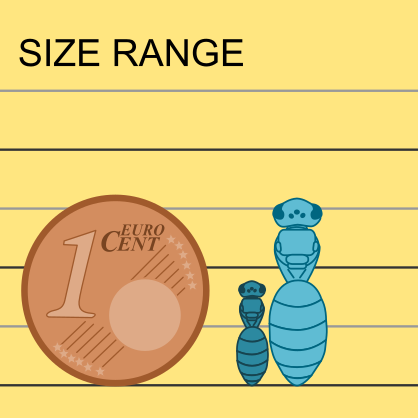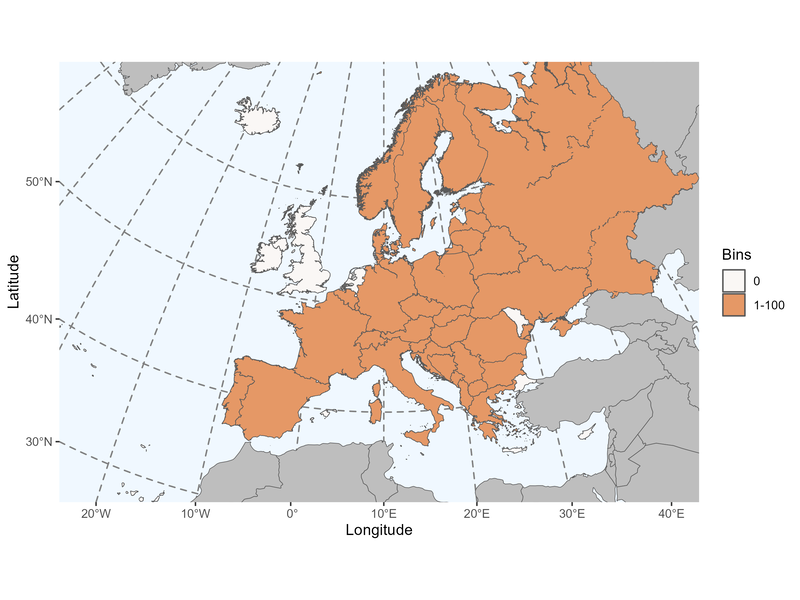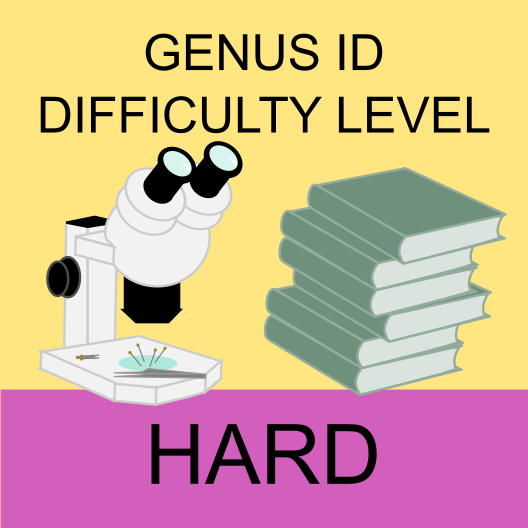Author: Panzer, 1804
|
Type species: Trachusa serratulae Panzer, 1804 = Apis byssina Panzer, 1798, by designation of Sandhouse, 1943.
Subgenera: Archianthidium Mavromoustakis, 1939; Paraanthidium Friese, 1898; Trachusa s.str. Panzer, 1804. Synonyms: Protanthidium Cockerell and Cockerell, 1901; Protoanthidium Cameron, 1902; Diphysis Lepeletier, 1841; Megachileoides Radoszkowski, 1874; Megachiloides Saussure, 1890. |
Clade: Anthophila
Family: Megachilidae SubF: Megachilinae Tribe: Anthidiini |
|
Distinctive traits
|
Pictures of distinctive traits.
|
Morphologically close genera and how to distinguish them
Rhodanthidium species have at least one apical tooth on the dorso-apical plate of the posterior tibia.
Afranthidium, Anthidium, Icteranthidium & Pseudoanthidium species don't have an arolium between their claws.
Anthidiellum species have a subrectangular, posteriorly extended scutellum and are much smaller.
Eoanthidium species have a carinate antennal fossa.
Stelis species may have pointed axillae, males have two widely separated apical teeth on their anterior and median tibiae and females have no ventral scopa.
Melitturga species have a truncated marginal cell, a second recurrent vein anteriorly connecting at the second submarginal cell, males with enlarged eyes and females without a ventral brush.
- Trachusa - Rhodanthidium
Rhodanthidium species have at least one apical tooth on the dorso-apical plate of the posterior tibia.
- Trachusa - Afranthidium, Anthidium, Icteranthidium & Pseudoanthidium
Afranthidium, Anthidium, Icteranthidium & Pseudoanthidium species don't have an arolium between their claws.
- Trachusa - Anthidiellum
Anthidiellum species have a subrectangular, posteriorly extended scutellum and are much smaller.
- Trachusa - Eoanthidium
Eoanthidium species have a carinate antennal fossa.
- Trachusa - Stelis
Stelis species may have pointed axillae, males have two widely separated apical teeth on their anterior and median tibiae and females have no ventral scopa.
- Trachusa - Melitturga
Melitturga species have a truncated marginal cell, a second recurrent vein anteriorly connecting at the second submarginal cell, males with enlarged eyes and females without a ventral brush.
General comments on Trachusa species identification
Diagnostic characters for species identification are located on the mandibles, maxillary palps, scutellum and axillae, as well as genitalia and sternites. These area should be made visible as far as possible.
Diagnostic characters for species identification are located on the mandibles, maxillary palps, scutellum and axillae, as well as genitalia and sternites. These area should be made visible as far as possible.
Sorry, but the species identification tool is not yet available for Trachusa.
Please check the reference(s) below for traditional keys.
Please check the reference(s) below for traditional keys.
List of the 9 Trachusa species found in Europe (Ghisbain et al. 2023):
Trachusa (Archianthidium) balcanica Kasparek, 2018
Trachusa (Archianthidium) laeviventris (Dours, 1873)
Trachusa (Archianthidium) laticeps (Morawitz, 1873)
Trachusa (Archianthidium) pubescens (Morawitz, 1872)
Trachusa (Paraanthidium) dumerlei (Warncke, 1980)
Trachusa (Paraanthidium) integra (Eversmann, 1852)
Trachusa (Paraanthidium) interrupta (Fabricius, 1781)
Trachusa (Paraanthidium) varia (Olivier, 1789)
Trachusa (Trachusa) byssina (Panzer, 1798)
Trachusa (Archianthidium) balcanica Kasparek, 2018
Trachusa (Archianthidium) laeviventris (Dours, 1873)
Trachusa (Archianthidium) laticeps (Morawitz, 1873)
Trachusa (Archianthidium) pubescens (Morawitz, 1872)
Trachusa (Paraanthidium) dumerlei (Warncke, 1980)
Trachusa (Paraanthidium) integra (Eversmann, 1852)
Trachusa (Paraanthidium) interrupta (Fabricius, 1781)
Trachusa (Paraanthidium) varia (Olivier, 1789)
Trachusa (Trachusa) byssina (Panzer, 1798)
References with identification keys for some of the species:
- Warncke, K. 1980. Die Bienengattung Anthidium Fabricius, 1804 in der Westpaläarktis und im turkestanischen Becken. Entomofauna 1(10): 119-210.
- Kasparek M. (2017) Resin bees of the anthidiine genus Trachusa - Identification, taxonomy, distribution and biology of the Old World species. Entomofauna, supplement, 21, 1-155.
Online resources:
Atlas hymenoptera (Belgium)
Exotic Bee ID (World)
Discover Life (World)
WestPalBees (West Palearctic)
Atlas hymenoptera (Belgium)
Exotic Bee ID (World)
Discover Life (World)
WestPalBees (West Palearctic)
Page contributors:
You noticed a mistake? You have a suggestion to improve this page?
Don't keep it to yourself, please contact us and become a contributor to IDmyBee!
- Adrien Perrard (Dec. 2023)
- Adrien Perrard (Dec. 2019)
You noticed a mistake? You have a suggestion to improve this page?
Don't keep it to yourself, please contact us and become a contributor to IDmyBee!
References used to write this page:
- Ghisbain, G., Rosa, P., Bogusch, P., Flaminio, S., Le Divelec, R., Dorchin, A., Kasparek, M., Kuhlmann, M., Litman, J., Mignot, M., Müller, A., Praz, C., Radchenko, V.G., Rasmont, P., Risch, S., Roberts, S.P.M., Smit, J., Wood, T.J., Michez, D. & Reverte, S. (2023). The new annotated checklist of the wild bees of Europe (Hymenoptera: Anthophila). Zootaxa, 5327(1), 1-147.
- Kasparek, M., 2020. Revision of the Palaearctic Trachusa interrupta species complex (Apoidea: Anthidiini) with description of four new species. Zootaxa, 4728(1), pp.1-48.
- Michener, C.D. 2007. The Bees of the World, 2nd Edition. The John Hopkins University Press, Baltimore.
- Michez D., Rasmont P., Terzo, M., Vereecken, N. 2019. Abeilles d'Europes. Hymenoptères d'Europes, Volume 1. N.A.P. Editions.
- Nieto, A., Roberts, S. P., Kemp, J., Rasmont, P., Kuhlmann, M., García Criado, M., ... & Michez, D. 2014. European red list of bees. Luxembourg: Publication Office of the European Union, 98.
- Rasmont, P., Devalez, Jelle, Pauly, A., Michez, D. & Radchenko, V.G. 2017. Addition to the checklist of IUCN European wild bees (Hymenoptera: Apoidea). Annales de la Société entomologique de France 53: 17-32.



